MDA-Based Approach for Blockchain Smart Contract Development
Abstract
1. Introduction
2. Related Work
3. MDA-Based Smart Contract Development Method
3.1. Blockchain CIM Definition
3.2. Transformation from Blockchain CIM to Blockchain PIM
3.3. Transformation from Blockchain PIM to Blockchain PSM
3.4. Transformation from Blockchain PSM to Smart Contract Code
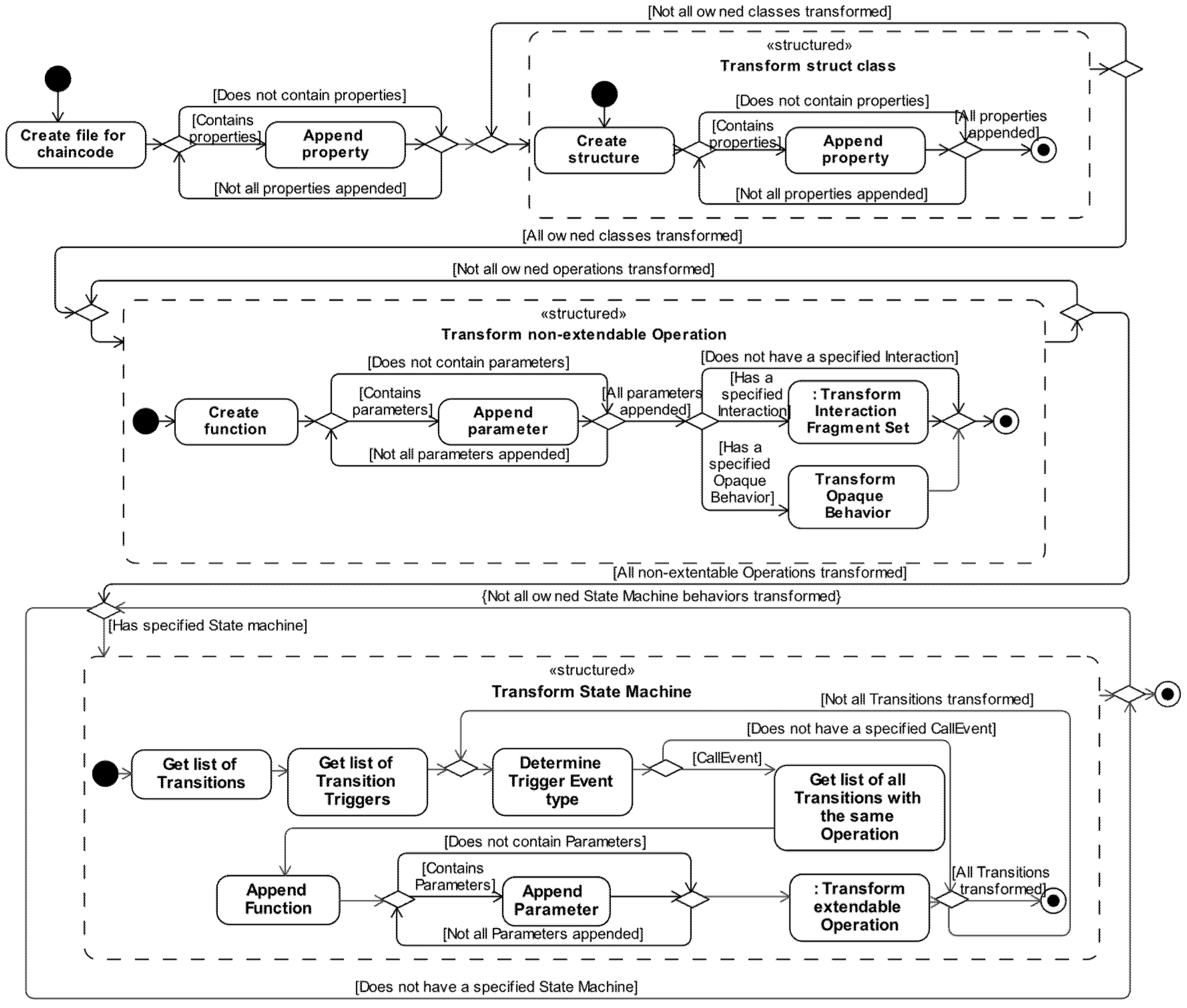
4. Application of the MDAsmartCD Method for Development of Hackathon Certificate Issuing Solution
4.1. Blockchain CIM for HackChain
4.2. Blockchain PIM for HackChain
4.3. Ethereum PSM for HackChain
4.4. Hyperledger Fabric PSM for HackChain
4.5. The Metrics of the Developed HackChain Models and the Generated Code
| HackChain Solidity Smart Contract | ||||
| Executed Function | NLOC | CCN | Token | Parameters |
| createCertificate | 7 | 1 | 109 | 9 |
| confirmEvaluationResults | 10 | 4 | 74 | 3 |
| HackChain Go Chaincode | ||||
| Executed Function | NLOC | CCN | Token | Parameters |
| CreateCertificate | 16 | 3 | 154 | 10 |
| ConfirmEvaluationResults | 24 | 7 | 142 | 4 |

- Nine participant certificates were confirmed to have submitted valid solutions, the solution references were updated, and the certificates were updated to the ISSUED_FOR_SOLUTION state.
- Six hackathon participant certificates were updated to the ISSUED_FOR_PARTICIPATION state, as they were determined to have submitted an invalid solution (the reference to a solution was also updated).
- The remaining three participant certificates were updated to the ISSUED_FOR_PARTICIPATION state, as participants have not submitted a solution.
5. Discussion and Conclusions
Author Contributions
Funding
Institutional Review Board Statement
Informed Consent Statement
Data Availability Statement
Conflicts of Interest
References
- Monrat, A.A.; Schelén, O.; Andersson, K. A Survey of Blockchain From the Perspectives of Applications, Challenges, and Opportunities. IEEE Access 2019, 7, 117134–117151. [Google Scholar] [CrossRef]
- Metcalfe, W. Ethereum, Smart Contracts, DApps. In Blockchain and Crypto Currency; Yano, M., Dai, C., Masuda, K., Kishimoto, Y., Eds.; Springer: Singapore, 2020; pp. 77–93. ISBN 978-981-15-3376-1. [Google Scholar]
- Zou, W.; Lo, D.; Kochhar, P.S.; Le, X.B.D.; Xia, X.; Feng, Y.; Chen, Z.; Xu, B. Smart Contract Development: Challenges and Opportunities. IEEE Trans. Softw. Eng. 2019, 47, 2084–2106. [Google Scholar] [CrossRef]
- Berdik, D.; Otoum, S.; Schmidt, N.; Porter, D.; Jararweh, Y. A Survey on Blockchain for Information Systems Management and Security. Inf. Process. Manag. 2021, 58, 102397. [Google Scholar] [CrossRef]
- Sánchez-Gómez, N.; Torres-Valderrama, J.; García-García, J.A.; Gutiérrez, J.J.; Escalona, M.J. Model-Based Software Design and Testing in Blockchain Smart Contracts: A Systematic Literature Review. IEEE Access 2020, 8, 164556–164569. [Google Scholar] [CrossRef]
- Fahmideh, M.; Grundy, J.; Ahmad, A.; Shen, J.; Yan, J.; Mougouei, D.; Wang, P.; Ghose, A.; Gunawardana, A.; Aickelin, U.; et al. Engineering Blockchain-based Software Systems: Foundations, Survey, and Future Directions. ACM Comput. Surv. 2022, 55, 1–44. [Google Scholar] [CrossRef]
- Miraz, M.H.; Ali, M. Blockchain Enabled Smart Contract Based Applications: Deficiencies with the Software Development Life Cycle Models. Baltica 2020, 33, 101–116. [Google Scholar]
- Zheng, Z.; Xie, S.; Dai, H.N.; Chen, W.; Chen, X.; Weng, J.; Imran, M. An overview on smart contracts: Challenges, advances and platforms. Future Gener. Comput. Syst. 2020, 105, 475–491. [Google Scholar] [CrossRef]
- Vacca, A.; Sorbo, A.D.; Visaggio, C.A.; Canfora, G. A systematic literature review of blockchain and smart contract development: Techniques, tools, and open challenges. J. Syst. Softw. 2021, 174, 110891. [Google Scholar] [CrossRef]
- Sebastián, G.; Gallud, J.A.; Tesoriero, R. Code generation using model driven architecture: A systematic mapping study. J. Comput. Lang. 2020, 56, 100935. [Google Scholar] [CrossRef]
- Levasseur, O.; Iqbal, M.; Matulevičius, R. Survey of Model-Driven Engineering Techniques for Blockchain-Based Applications. In Proceedings of the Forum at Practice of Enterprise Modeling 2021, Riga, Latvia, 24–26 November 2021. [Google Scholar]
- Hsain, Y.A.; Laaz, N.; Mbarki, N.L. Ethereum’s Smart Contracts Construction and Development using Model Driven Engineering Technologies: A Review. Proc. Comput. Sci. 2021, 184, 785–790. [Google Scholar] [CrossRef]
- Object Management Group. Model Driven Architecture (MDA) MDA Guide rev. 2.0. 2014. Available online: https://www.omg.org/cgi-bin/doc?ormsc/14-06-01 (accessed on 13 November 2022).
- Pastor, O.; Molina, J.C. Model-Driven Architecture in Practice; Springer: Berlin, Heidelberg, 2007; ISBN 978-3-540-71868-0. [Google Scholar]
- Curty, S.; Härer, F.; Fill, H.G. Blockchain Application Development Using Model-Driven Engineering and Low-Code Platforms: A Survey. In Proceedings of the International Conference on Business Process Modeling, Development and Support, International Conference on Evaluation and Modeling Methods for Systems Analysis and Development, Leuven, Belgium, 6–7 June 2022; pp. 205–220. [Google Scholar]
- Skotnica, M.; Klicpera, J.; Pergl, R. Towards Model-Driven Smart Contract Systems—Code Generation and Improving Expressivity of Smart Contract Modeling. In Proceedings of the 20th CIAO! Doctoral Consortium, and Enterprise Engineering Working Conference Forum 2020, Bolzano, Italy, 28 September–19 October 2020, 9–10 November 2020; pp. 1–15. [Google Scholar]
- Hu, K.; Zhu, J.; Ding, Y.; Bai, X.; Huang, J. Smart Contract Engineering. Electronics 2020, 9, 2042. [Google Scholar] [CrossRef]
- Boogaard, K. A Model-Driven Approach to Smart Contract Development. Master Thesis, Utrecht University, Utrecht, The Netherlands, 2018. [Google Scholar]
- Syahputra, H.; Weigand, H. The Development of Smart Contracts for Heterogeneous Blockchains. In Enterprise Interoperability VIII. Proceedings of the I-ESA Conferences; Popplewell, K., Thoben, K.D., Knothe, T., Poler, R., Eds.; Springer: Cham, Switzerland, 2019; ISBN 978-3-030-13692-2. [Google Scholar]
- Sousa, V.A.; Burnay, C. MDE4BBIS: A Framework to Incorporate Model-Driven Engineering in the Development of Blockchain-Based Information Systems. In Proceedings of the 2021 Third International Conference on Blockchain Computing and Applications (BCCA), Tartu, Estonia, 15–17 November 2021; pp. 195–200. [Google Scholar]
- Jurgelaitis, M.; Drungilas, V.; Čeponienė, L.; Vaičiukynas, E.; Butkienė, R.; Čeponis, J. Smart Contract Code Generation from Platform Specific Model for Hyperledger Go. In Proceedings of the 9th World Conference on Information Systems and Technologies (WorldCIST’21), Terceira Island, Azores, Portugal, 30 March–2 April 2021; pp. 63–73. [Google Scholar]
- Jurgelaitis, M.; Čeponienė, L.; Butkienė, R. Solidity Code Generation from UML State Machines in Model-Driven Smart Contract Development. IEEE Access 2022, 10, 33465–33481. [Google Scholar] [CrossRef]
- Górski, T.; Bednarski, J. Transformation of the UML Deployment Model into a Distributed Ledger Network Configuration. In Proceedings of the 2020 IEEE 15th International Conference of System of Systems Engineering (SoSE), Budapest, Hungary, 2–4 June 2020; pp. 255–260. [Google Scholar]
- Górski, T.; Bednarski, J. Applying Model-Driven Engineering to Distributed Ledger Deployment. IEEE Access 2020, 8, 118245–118261. [Google Scholar] [CrossRef]
- Gao, Z.; Jiang, L.; Xia, X.; Lo, D.; Grundy, J. Checking Smart Contracts with Structural Code Embedding. IEEE Trans. Softw. Eng. 2020, 47, 2874–2891. [Google Scholar] [CrossRef]
- Antal, C.; Cioara, T.; Anghel, I.; Anta, M.; Salomie, I. Distributed Ledger Technology Review and Decentralized Applications Development Guidelines. Futur. Int. 2021, 13, 62. [Google Scholar] [CrossRef]
- Pierro, G.A. Smart-Graph: Graphical Representations for Smart Contract on the Ethereum Blockchain. In Proceedings of the 2021 IEEE International Conference on Software Analysis, Evolution and Reengineering (SANER), Honolulu, HI, USA, 9–12 March 2021; pp. 708–714. [Google Scholar]
- Hamdaqa, M.; Met, L.A.P.; Qasse, I. iContractML 2.0: A domain-specific language for modeling and deploying smart contracts onto multiple blockchain platforms. Inf. Softw. Technol. 2022, 144, 106762. [Google Scholar] [CrossRef]
- Kim, H.M.; Laskowski, M. Toward an ontology-driven blockchain design for supply-chain provenance. Intell. Syst. Account. Financ. Manag. 2018, 25, 18–27. [Google Scholar] [CrossRef]
- Zupan, N.; Kasinathan, P.; Cuellar, J.; Sauer, M. Secure Smart Contract Generation Based on Petri Nets. In Blockchain Technology for Industry 4.0. Blockchain Technologies; Rosa Righi, R., Alberti, A., Singh, M., Eds.; Springer: Singapore, 2020; pp. 73–98. ISBN 978-981-15-1137-0. [Google Scholar]
- Rocha, H.; Ducasse, S. Preliminary Steps Towards Modeling Blockchain Oriented Software. In Proceedings of the 2018 IEEE/ACM 1st International Workshop on Emerging Trends in Software Engineering for Blockchain (WETSEB), Gothenburg, Sweden, 27 May–3 June 2018; pp. 52–57. [Google Scholar]
- Garamvölgyi, P.; Kocsis, I.; Gehl, B.; Klenik, A. Towards Model-Driven Engineering of Smart Contracts for Cyber-Physical Systems. In Proceedings of the 2018 48th Annual IEEE/IFIP International Conference on Dependable Systems and Networks Workshops (DSN-W), Luxembourg, Luxembourg, 25–28 June 2018; pp. 134–139. [Google Scholar]
- Mavridou, A.; Laszka, A.; Stachtiari, E.; Dubey, A. VeriSolid: Correct-by-Design Smart Contracts for Ethereum. In Proceedings of the Financial Cryptography and Data Security 23rd International Conference, FC 2019, Frigate Bay, St. Kitts and Nevis, 18–22 February 2019; pp. 446–465. [Google Scholar]
- Kasinathan, P.; Martintoni, D.; Hofmann, B.; Senni, V.; Wimmer, M. Secure Remote Maintenance via Workflow-Driven Security Framework. In Proceedings of the 2021 IEEE International Conference on Blockchain (Blockchain), Melbourne, Australia, 6–8 December 2021; pp. 29–37. [Google Scholar]
- Marchesi, L.; Marchesi, M.; Tonelli, R. ABCDE—Agile block chain DApp engineering. Blockchain Res. Appl. 2020, 1, 100002. [Google Scholar] [CrossRef]
- Huning, L.; Iyenghar, P.; Pulvermüller, E. UML-based Model-Driven Code Generation of Error Detection Mechanisms. In Proceedings of the ICSEA 2020: The Fifteenth International Conference on Software Engineering Advances, Porto, Portugal, 18–22 October 2020. [Google Scholar]
- Lu, Q.; Binh Tran, A.; Weber, I.; O’Connor, H.; Rimba, P.; Xu, X.; Staples, M.; Zhu, L.; Jeffery, R. Integrated model-driven engineering of blockchain applications for business processes and asset management. Softw. Prac. Exp. 2021, 51, 1059–1079. [Google Scholar] [CrossRef]
- ERC|Ethereum Improvement Proposals. Available online: https://eips.ethereum.org/erc (accessed on 13 November 2022).
- Hyperledger Fabric Samples. Available online: https://github.com/hyperledger/fabric-samples (accessed on 13 November 2022).
- Amaral de Sousa, V.; Burnay, C.; Snoeck, M. B-MERODE: A Model-Driven Engineering and Artifact-Centric Approach to Generate Blockchain-Based Information Systems. In Advanced Information Systems Engineering. CAiSE 2020; Dustdar, S., Yu, E., Salinesi, C., Rieu, D., Pant, V., Eds.; Springer: Cham, Switzerland, 2020; pp. 117–133. ISBN 978-3-030-49435-3. [Google Scholar]
- Li, P.; Li, S.; Ding, M.; Yu, J.; Zhang, H.; Zhou, X.; Li, J. A Vulnerability Detection Framework for Hyperledger Fabric Smart Contracts Based on Dynamic and Static Analysis. In Proceedings of the International Conference on Evaluation and Assessment in Software Engineering 2022, Gothenburg, Sweden, 13–15 June 2022. [Google Scholar]
- Feist, J.; Grieco, G.; Groce, A. Slither: A Static Analysis Framework for Smart Contracts. In Proceedings of the 2019 IEEE/ACM 2nd International Workshop on Emerging Trends in Software Engineering for Blockchain (WETSEB), Montréal, Canada, 27 May 2019. [Google Scholar]
- Yin, T. Terryyin/Lizard: A Simple Code Complexity Analyser without Caring about the C/C++ Header Files or Java Imports, Supports Most of the Popular Languages. Available online: https://github.com/terryyin/lizard (accessed on 12 December 2022).
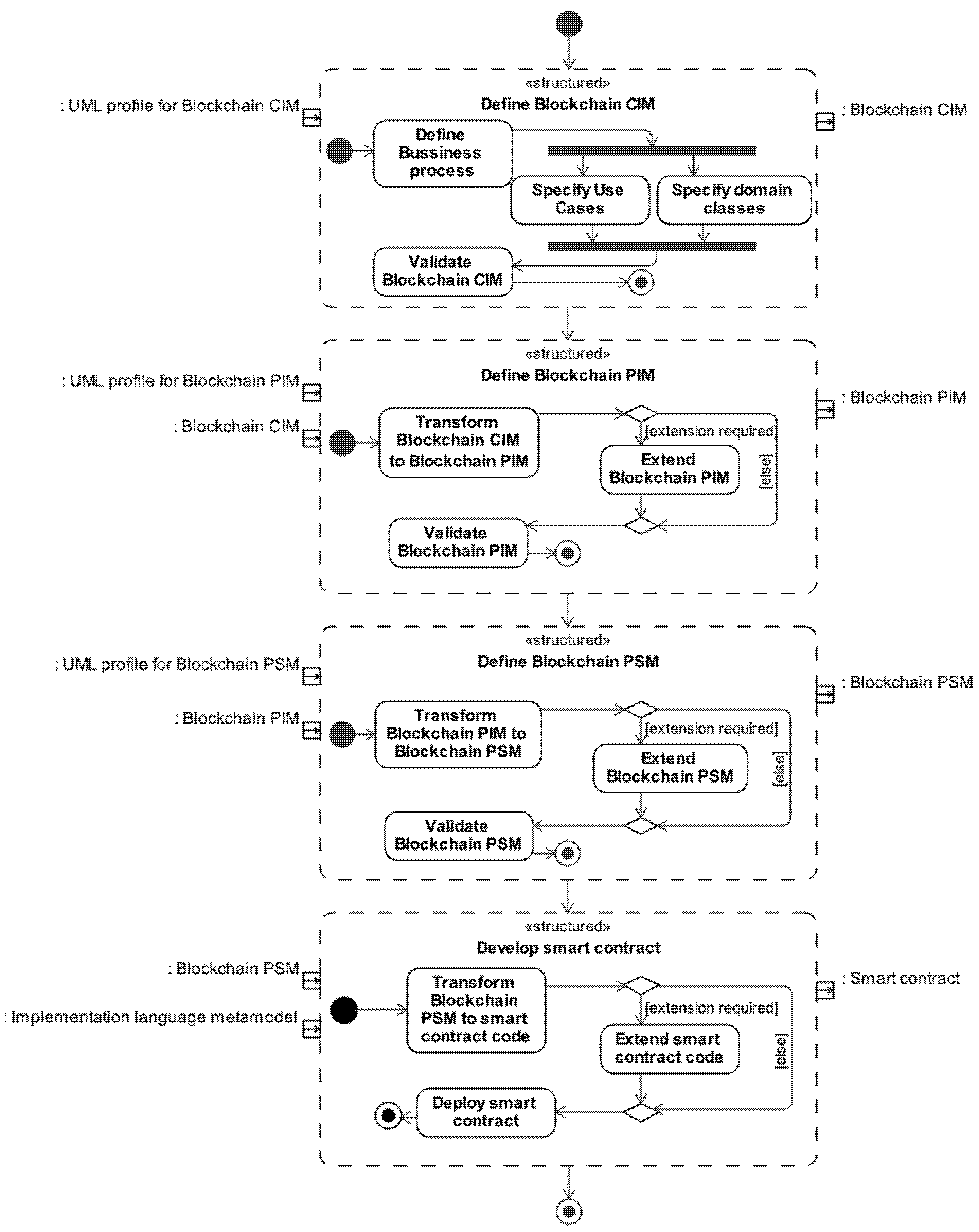
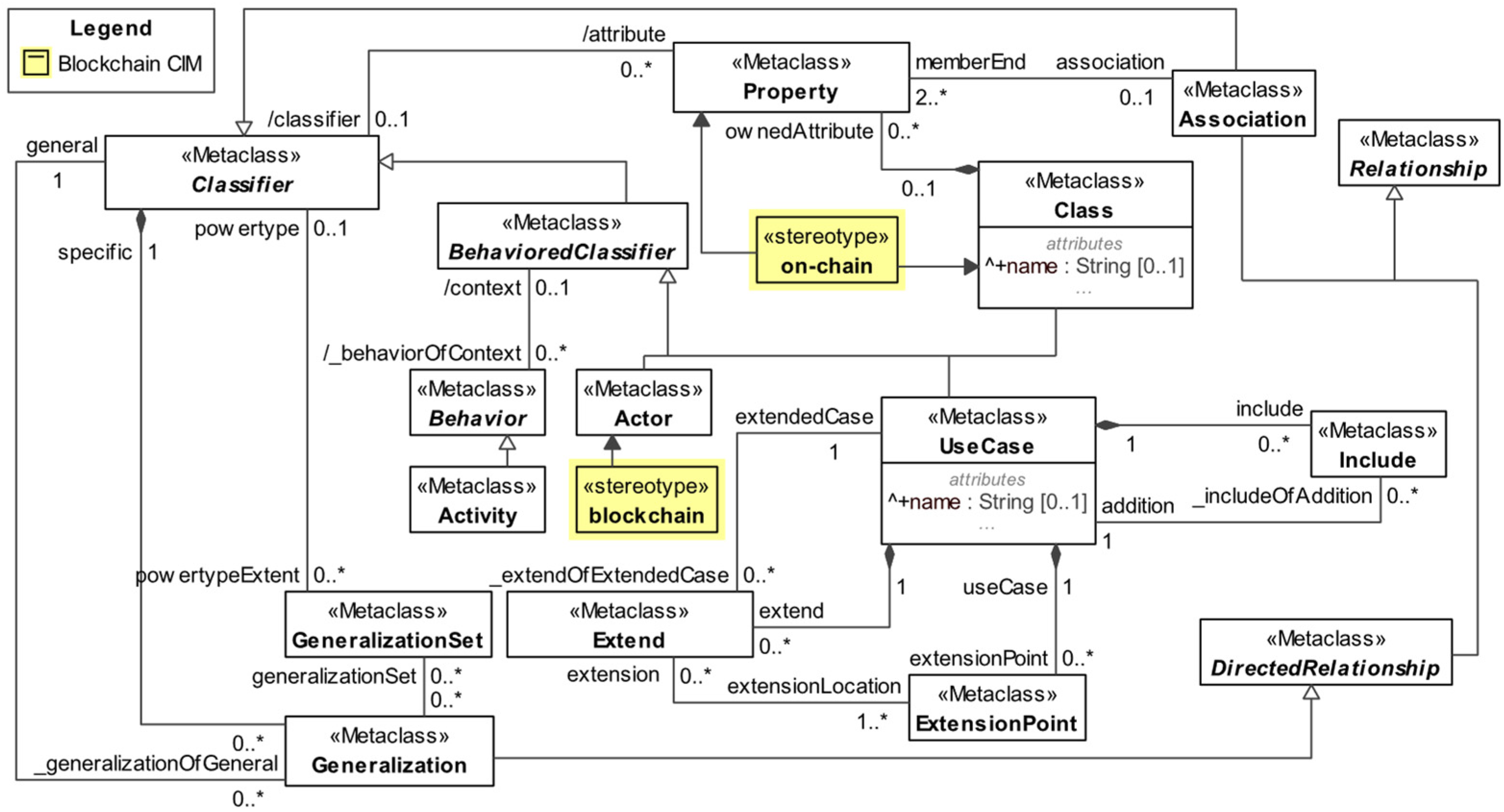
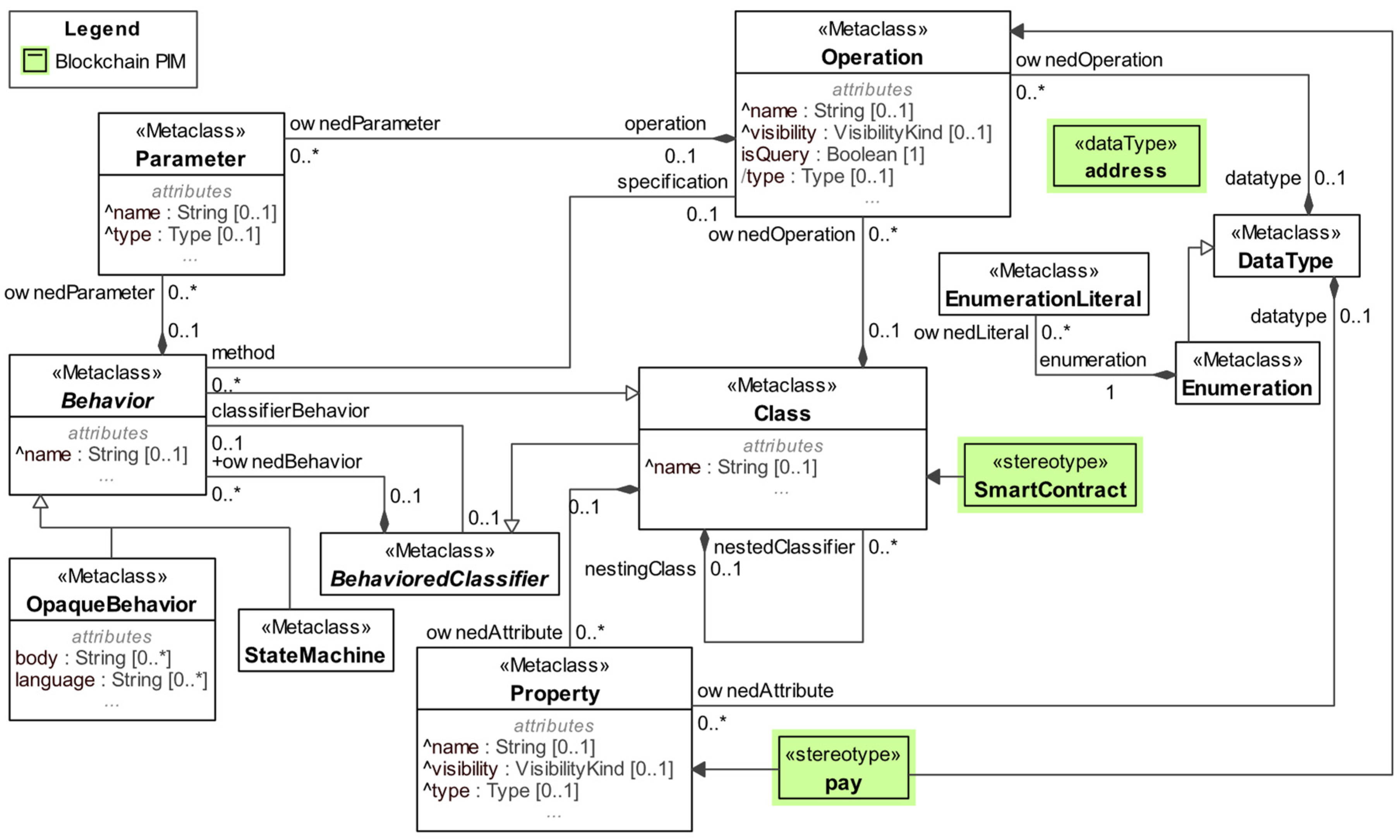
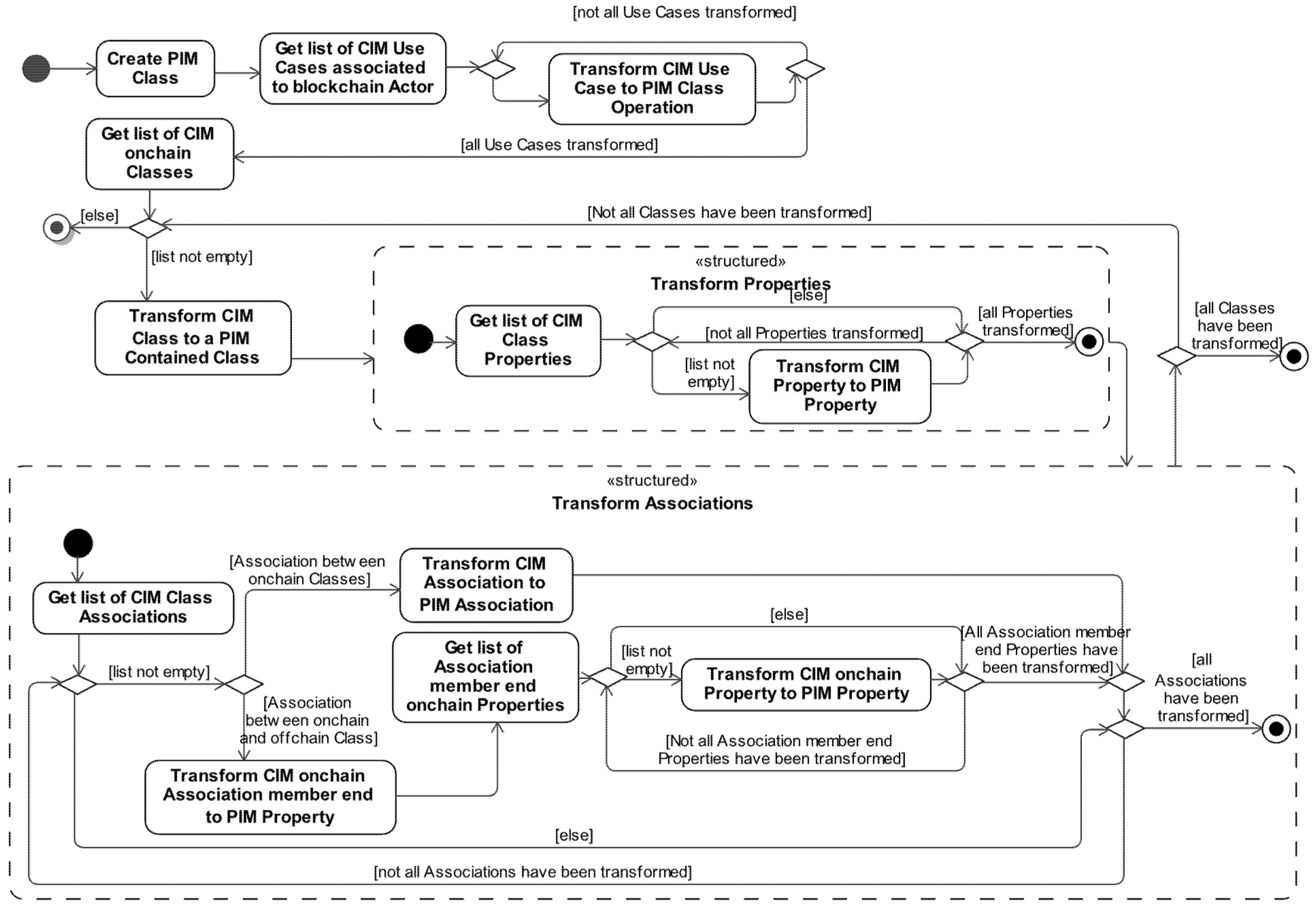
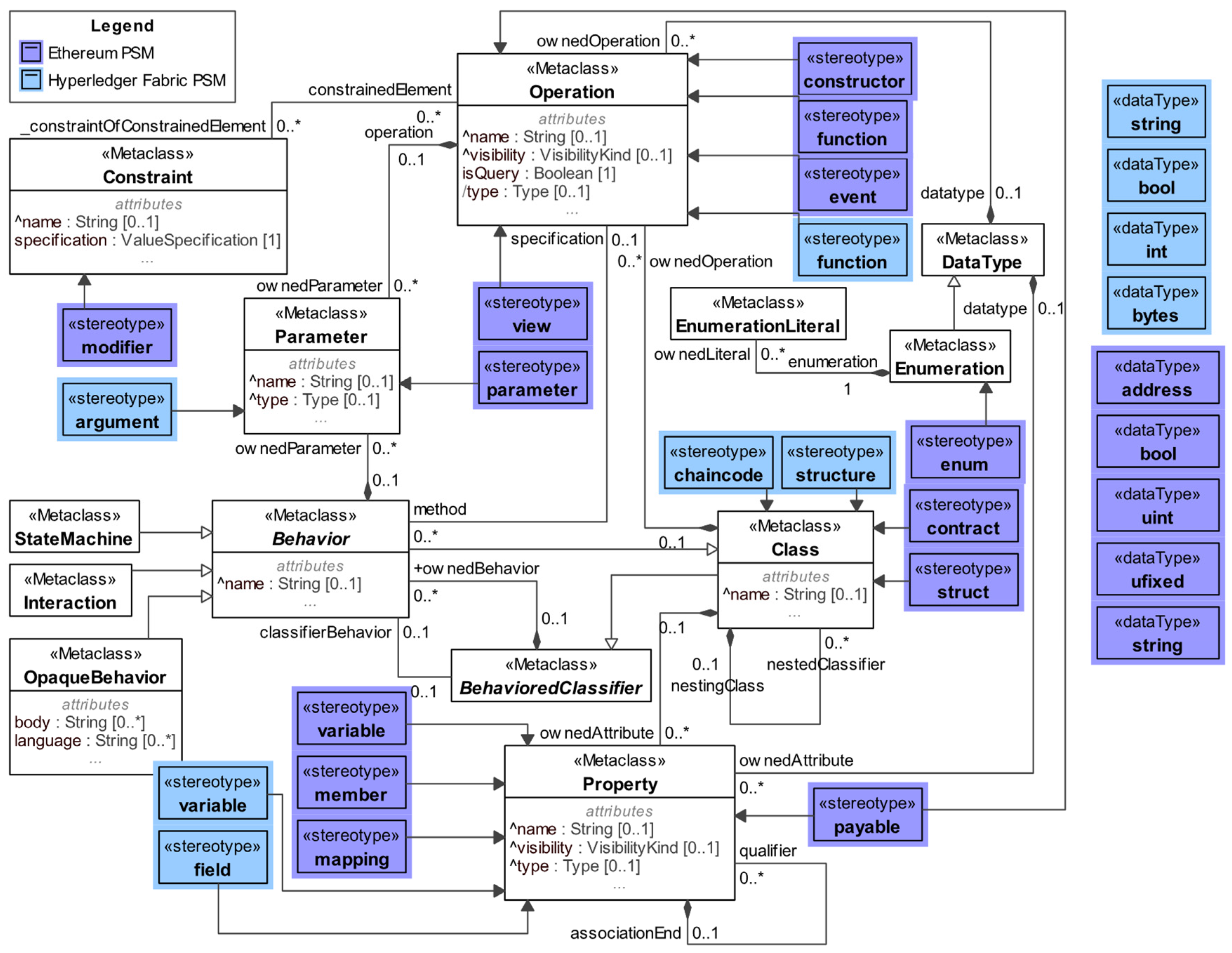
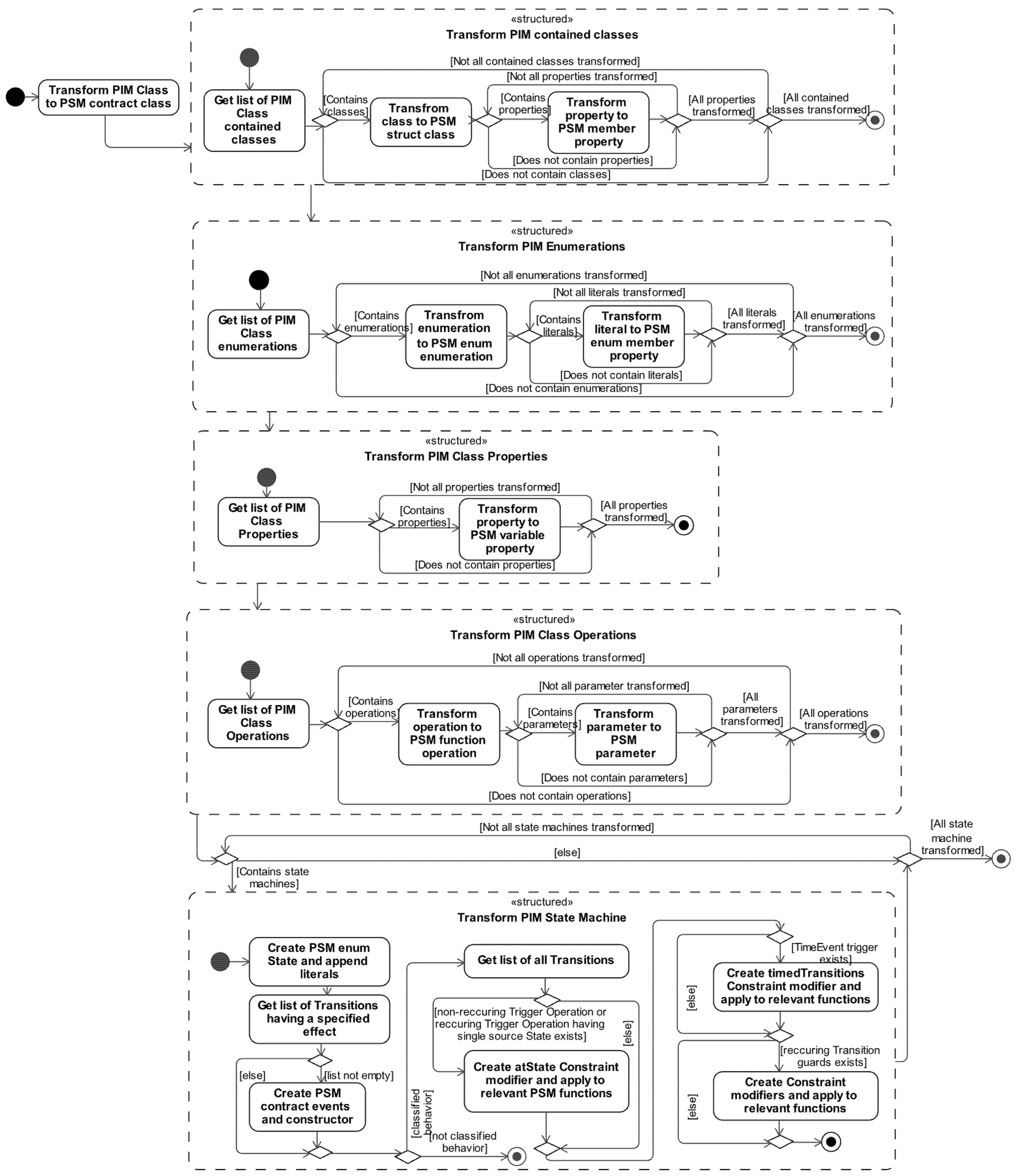
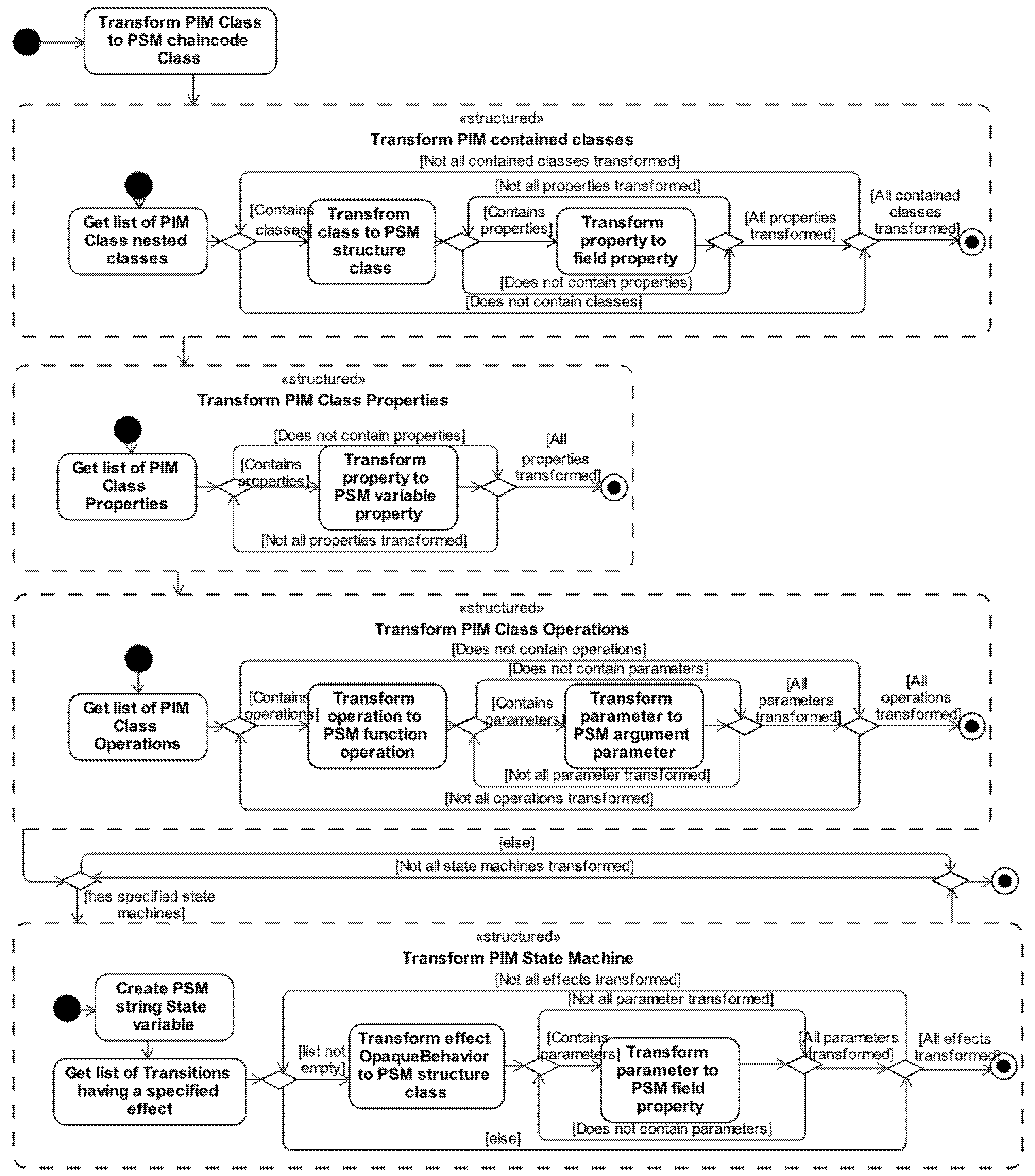

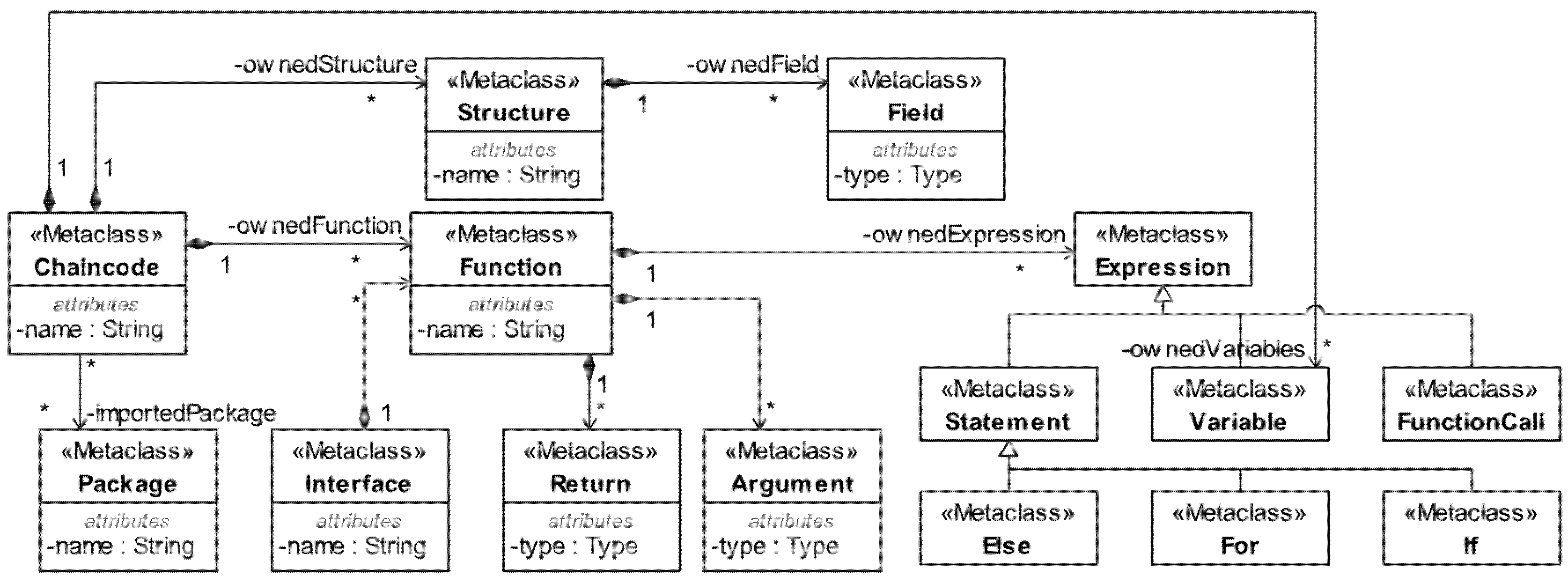
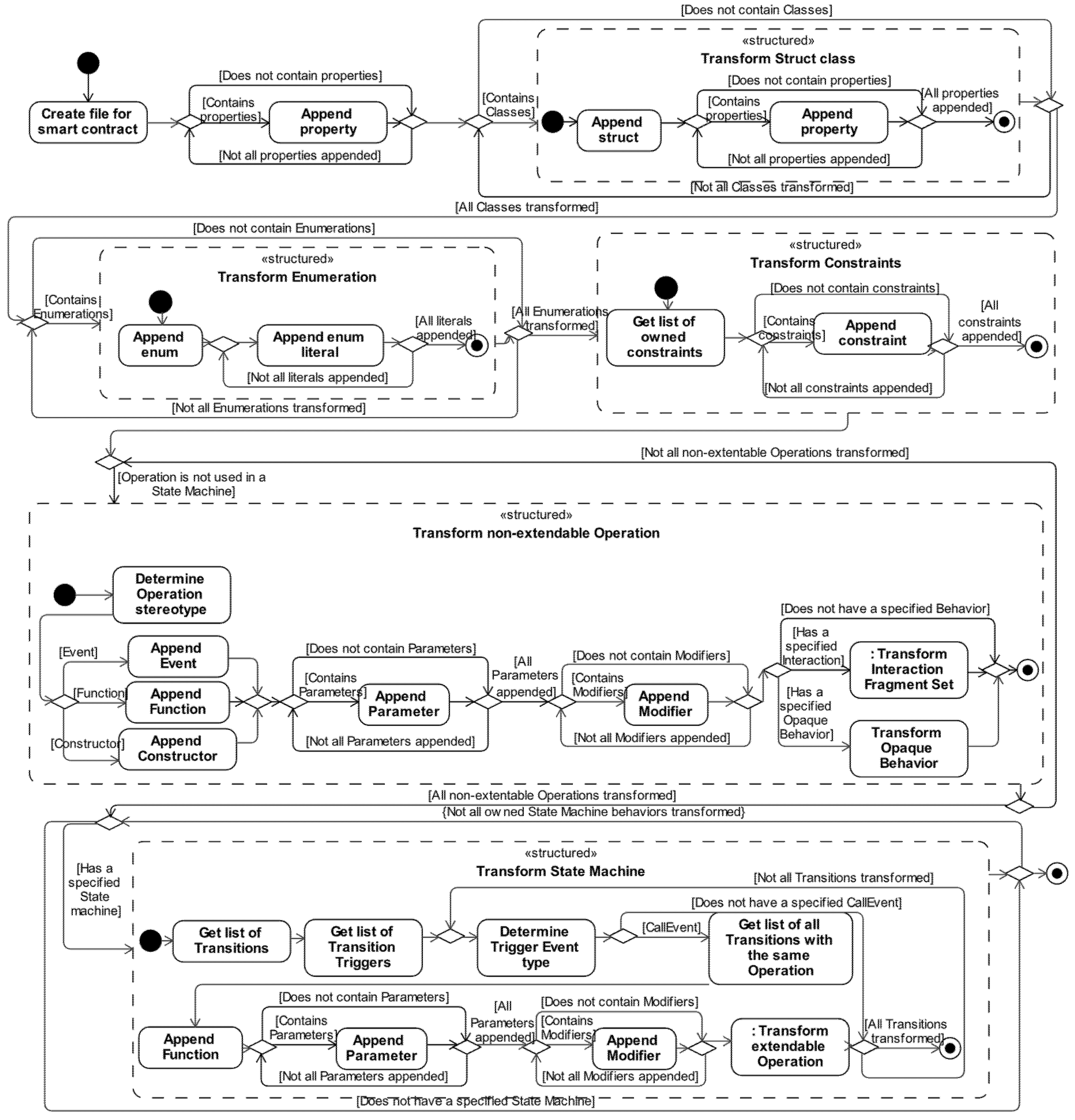
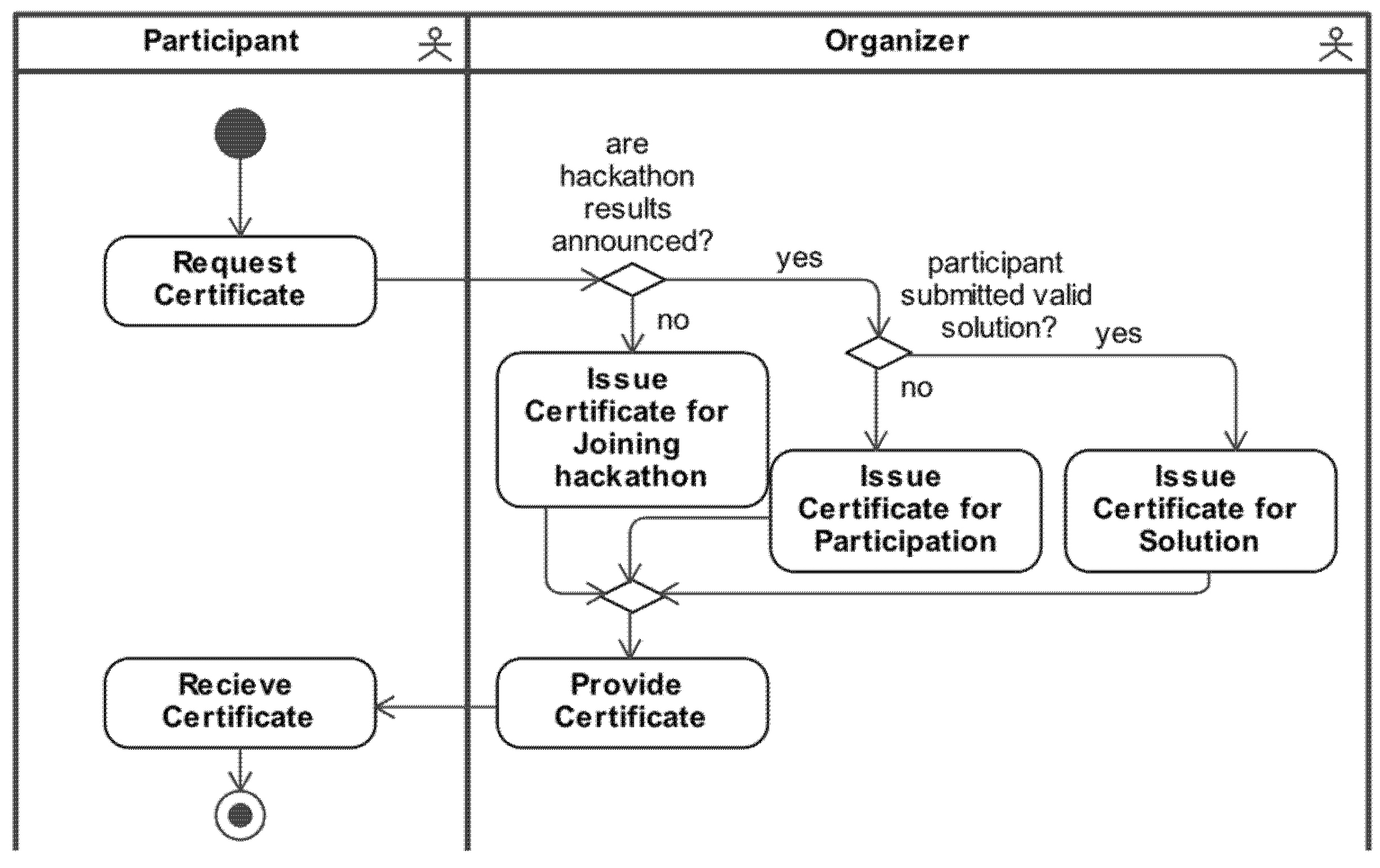
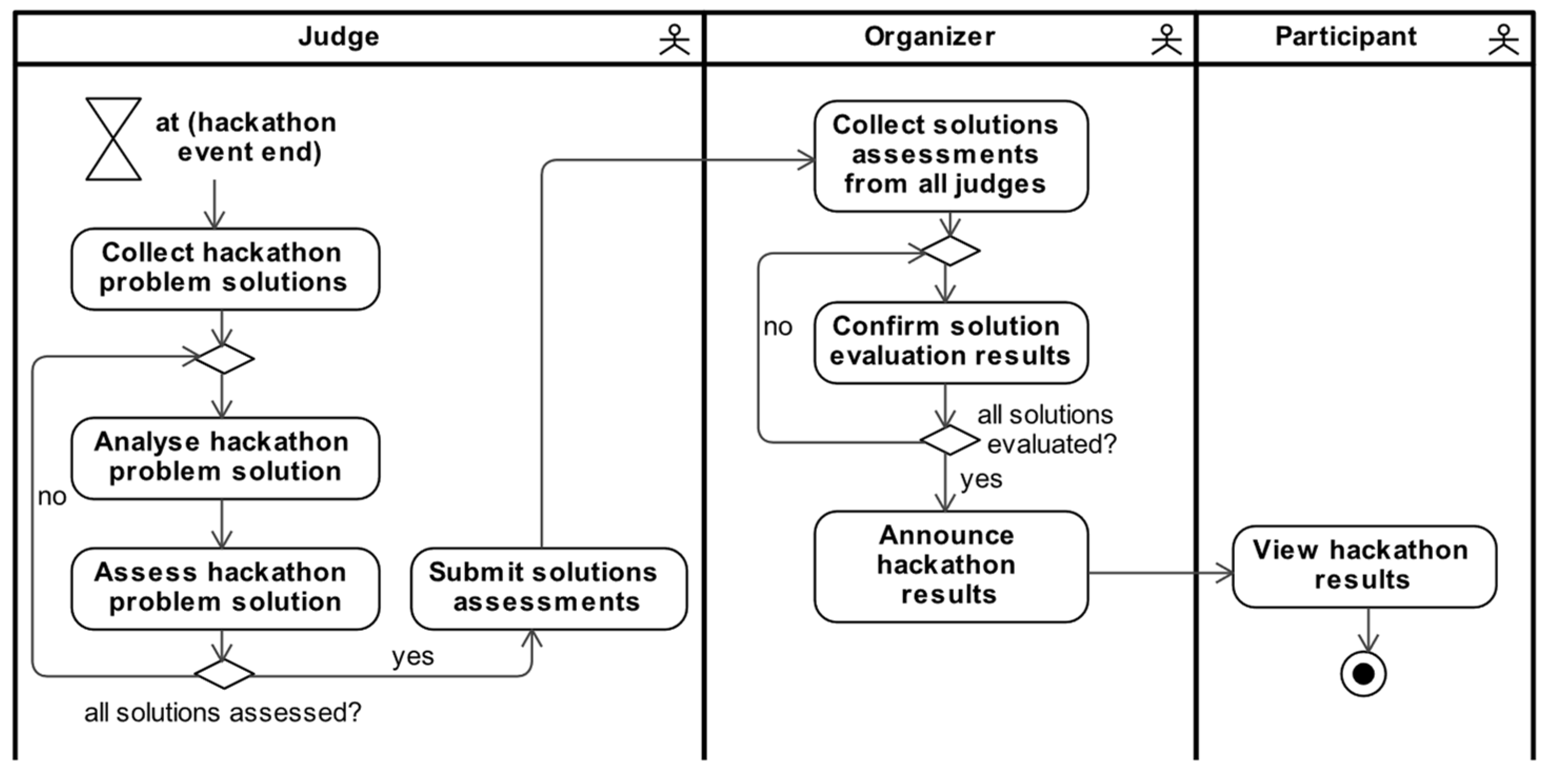
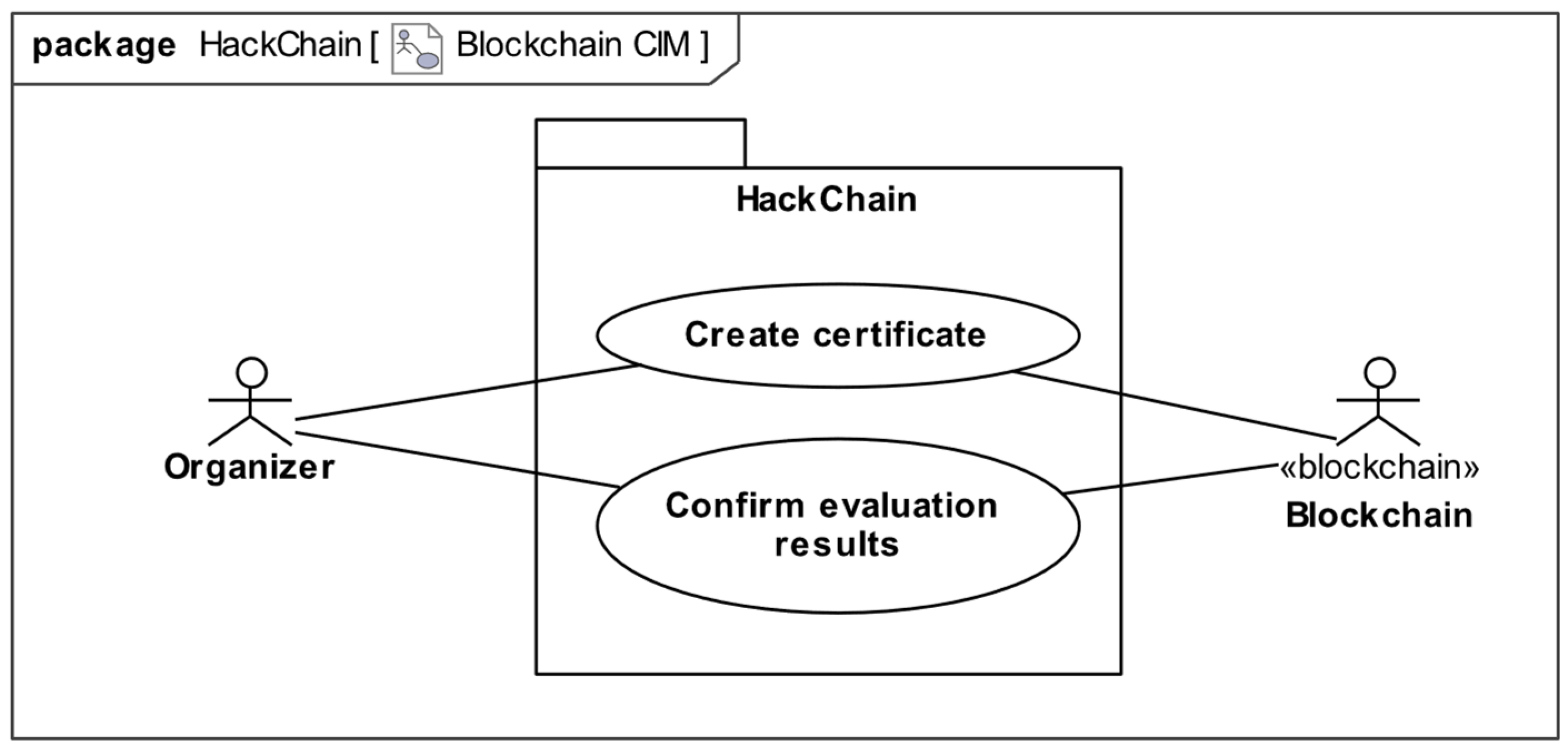
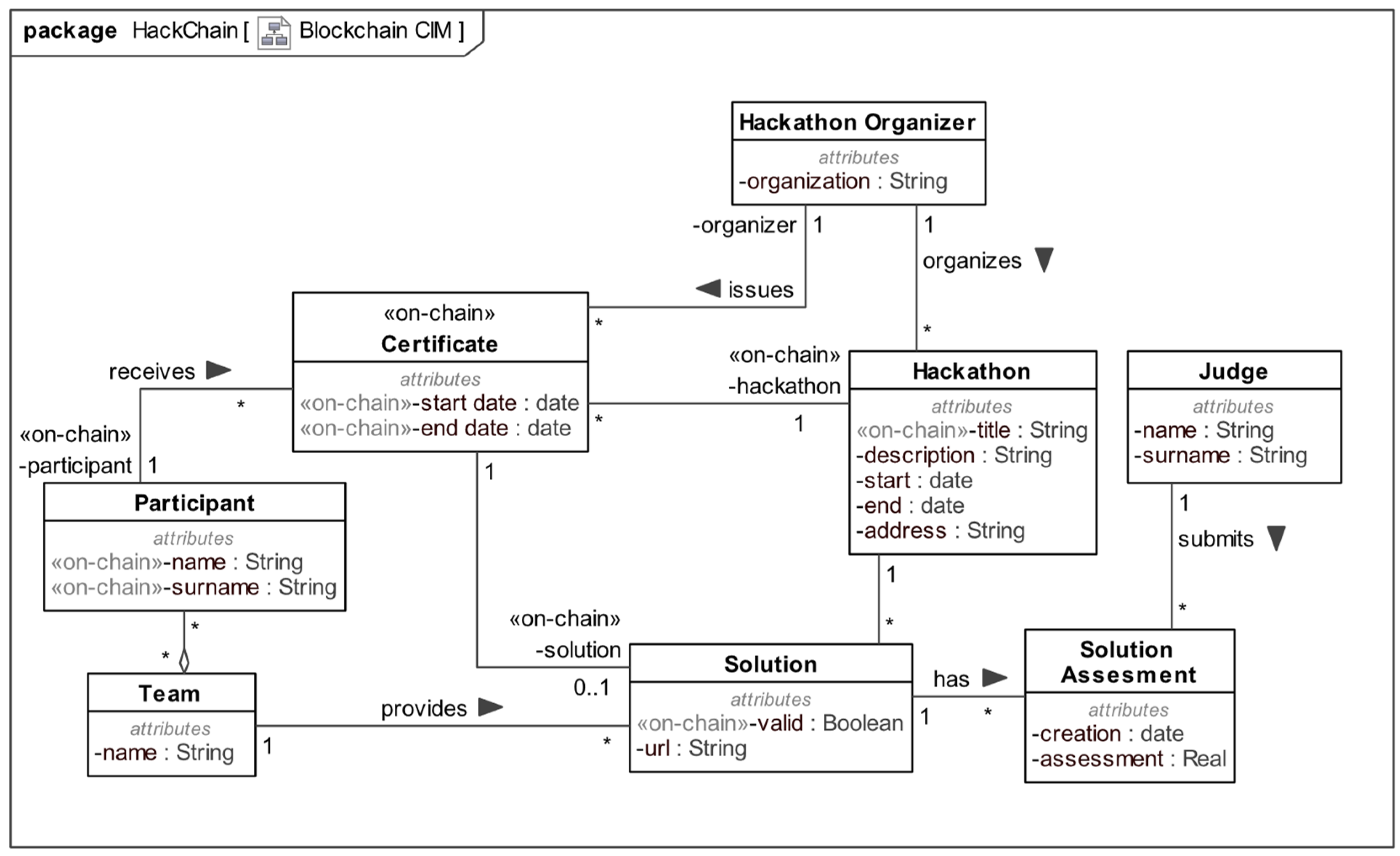

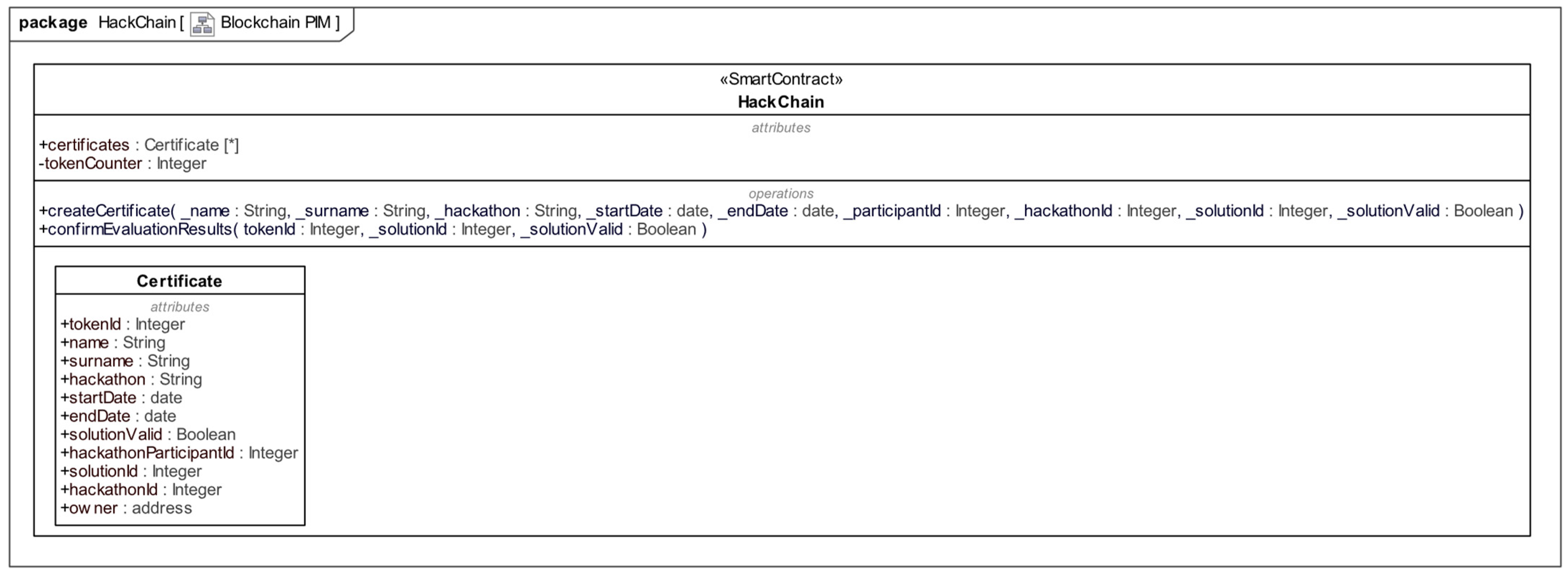

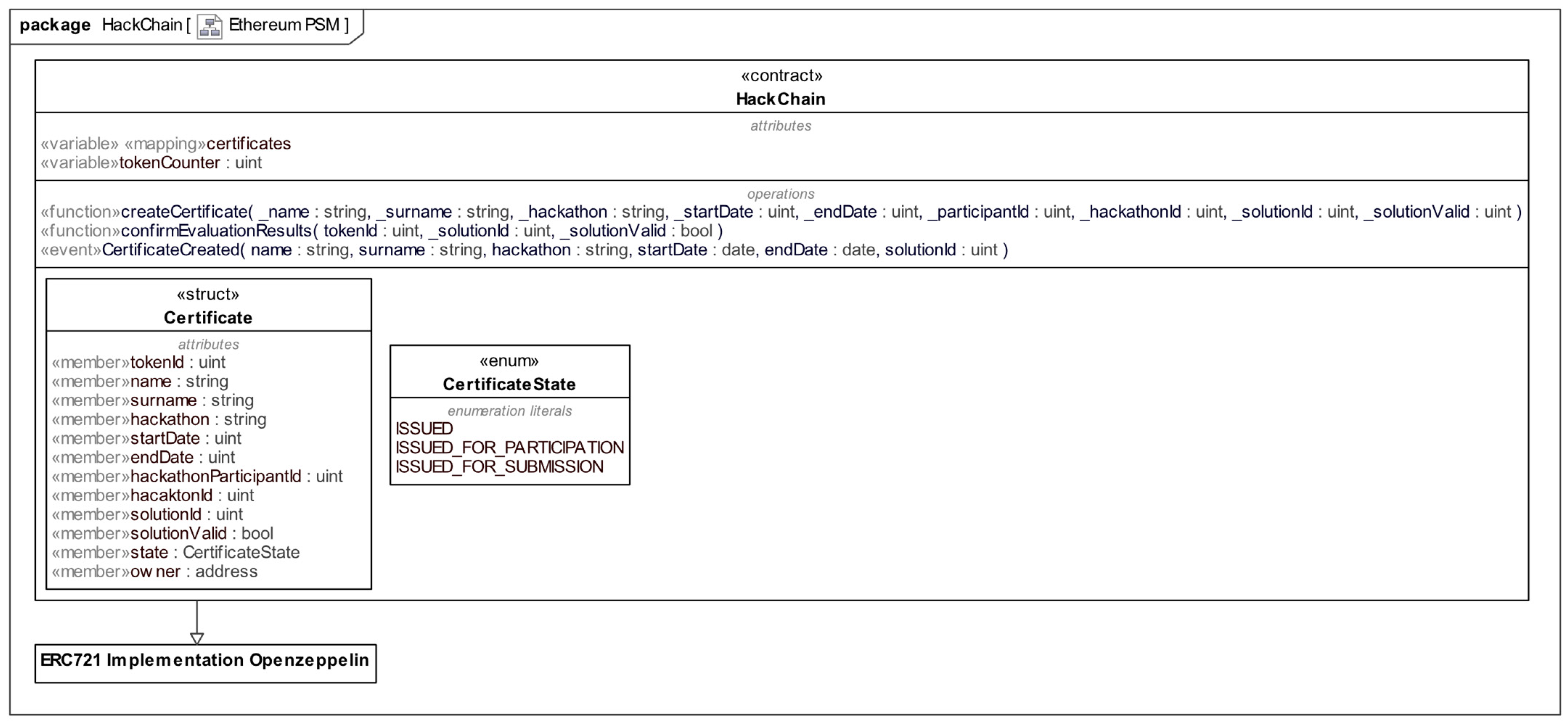
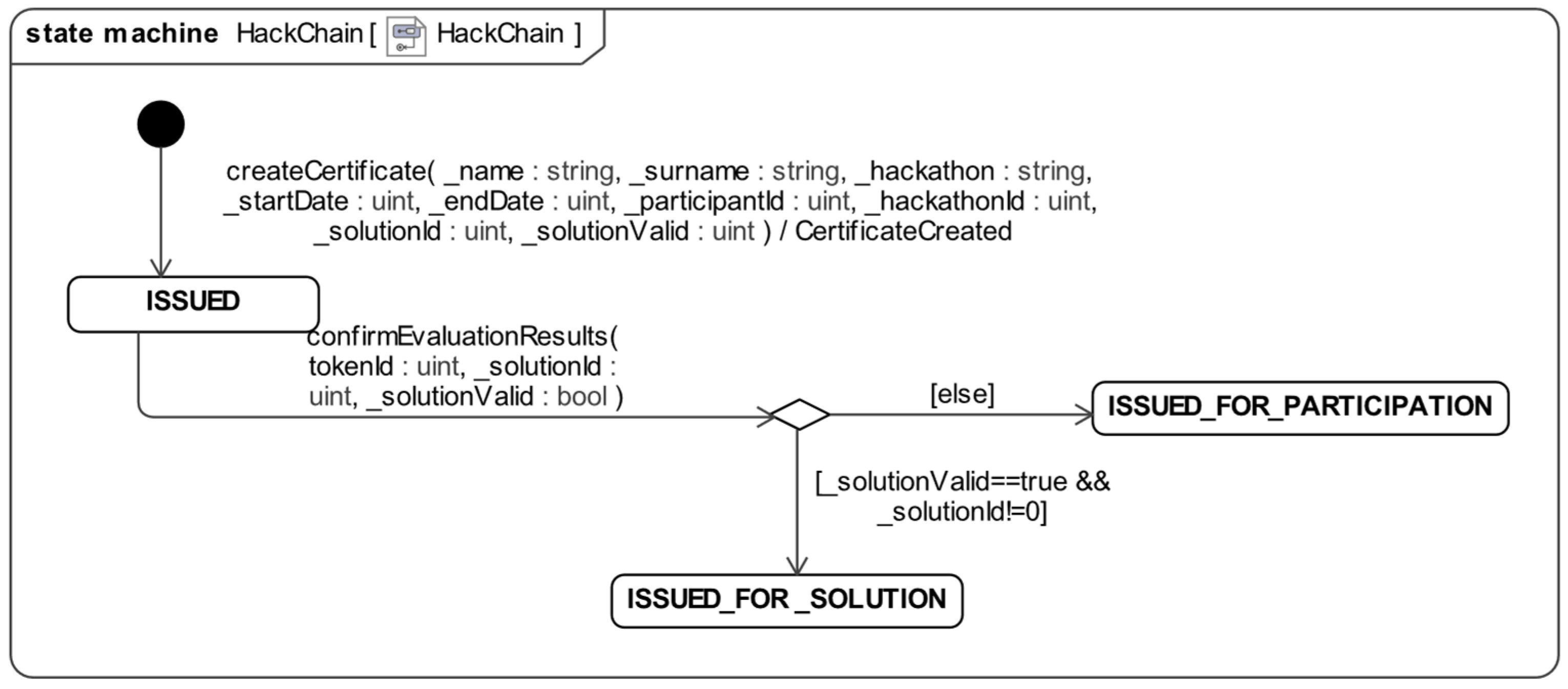
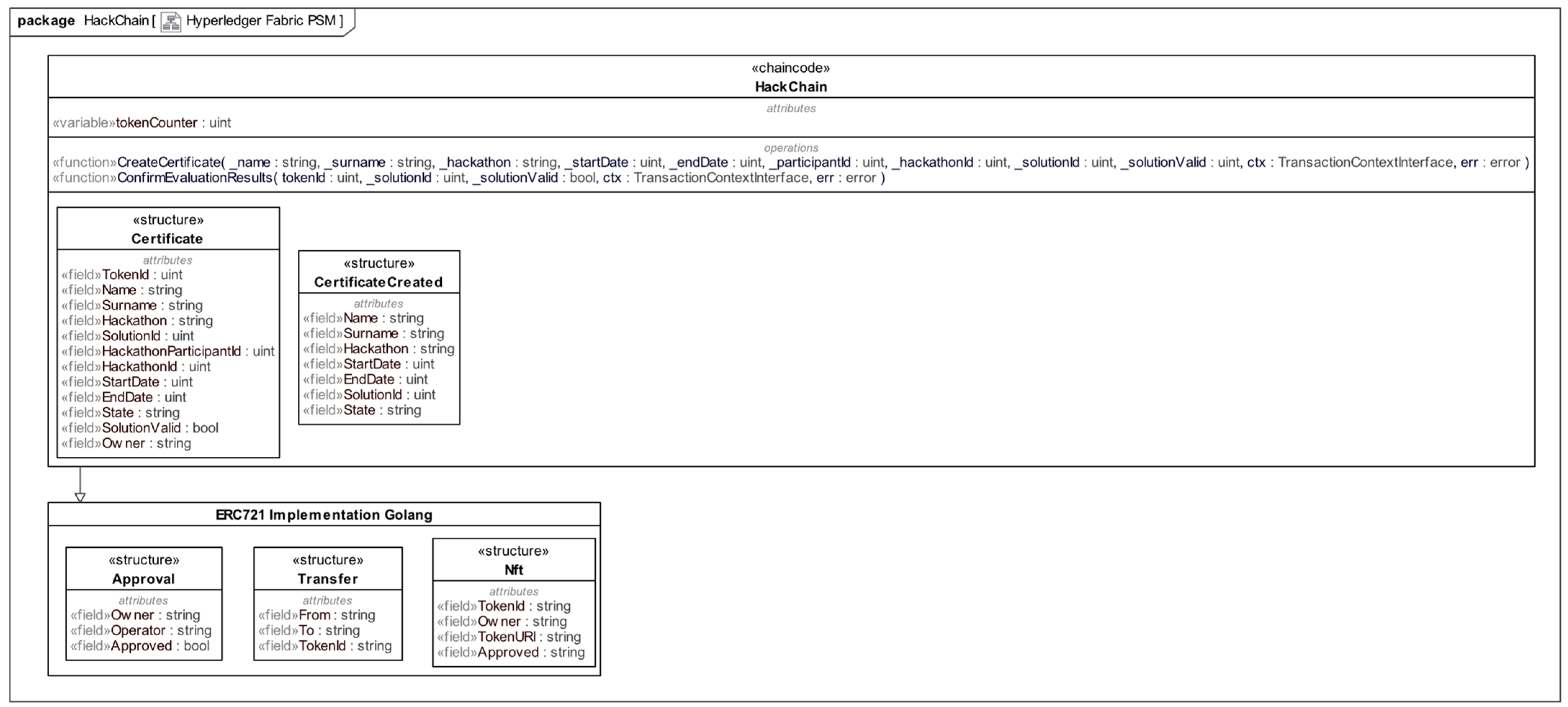
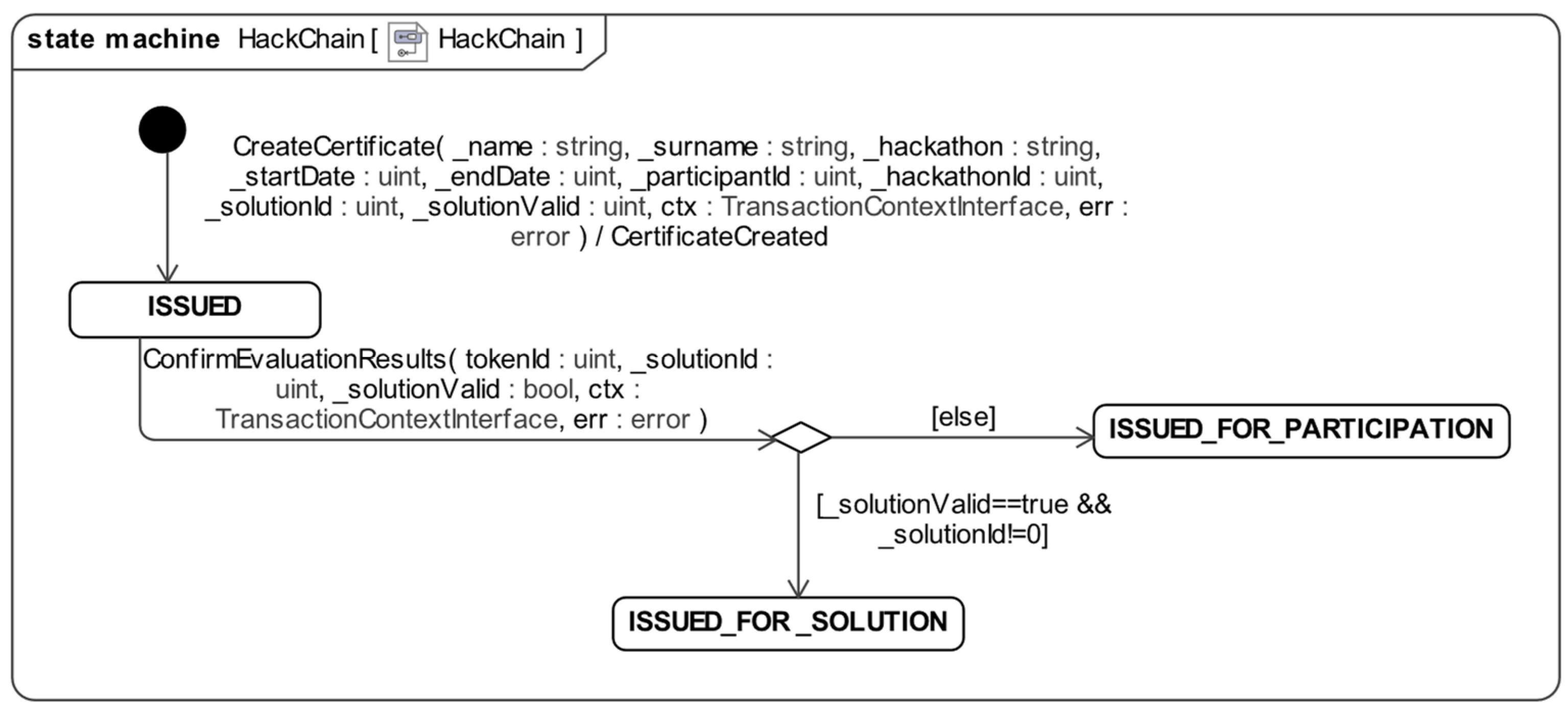
| [17] | [18] | [19] | [20] | MDAsmartCD | ||
|---|---|---|---|---|---|---|
| CIM | Specification Result | Contract parties agreement | ADICO statements | REA ontology | Does not employ CIM | Business process model Use case model Domain model |
| Specification Notation | Textual | Textual | UML class diagram | UML activity, use case, class diagram | ||
| Transformation from CIM to PIM | ATL (not yet implemented) | Manual | Manual | ATL | ||
| PIM | Specification Result | Abstract Formal Smart Contract Description | Smart contract state machine | Commitment-based ontology | Business logic model Blockchain Technical Design Model | Smart contract structure Smart contract behaviour |
| Specification Notation | Event-B | Finite State Machine | UML class diagram | B-MERODE | UML class, state machine diagram | |
| Transformation from PIM to PSM | ATL | Manual | Manual | Not defined | ATL | |
| PSM | Specification Result | Refined Formal Smart Contract Description | Solidity smart contract code | Commitment-based ontology | Object–Event Table Existence Dependency Graph | Smart contract structure Smart contract behaviour |
| Employed Notation | Event-B | Code produced directly from PIM | UML class diagram | Not defined | UML class, state machine, sequence diagram | |
| Transformation from PSM to code | Template-based technology | Acceleo M2T | Not defined | Acceleo M2T | ||
| Supported Platforms, Programming Languages | Ethereum Solidity | Ethereum Solidity | Ethereum Solidity Hyperledger Fabric Java | Ethereum Corda Hyperledger Fabric | Ethereum Solidity Hyperledger Fabric Go | |
| Element | Element Count |
|---|---|
| BlockchainCIM | |
| Business process (activity) | 2 |
| Actor | 2 |
| «blockchain» actor | 1 |
| Use case | 2 |
| Association between actor and use case | 4 |
| Class | 6 |
| Property | 13 |
| «on-chain» property | 6 |
| Association between classes | 8 |
| «on-chain» association member end | 4 |
| Blockchain PIM (Transformation Result) | |
| Class | 2 |
| «SmartContract» class | 1 |
| Operation | 2 |
| Operation parameter | 0 |
| Property | 9 |
| BlockchainPIM (after Extension) | |
| Class | 2 |
| «SmartContract» class | 1 |
| Operation | 2 |
| Operation parameter | 12 |
| Property | 13 |
| State | 3 |
| Transition | 4 |
| Effect | 1 |
| Guard | 2 |
| Transformation Result: Ethereum PSM | Transformation Result: Hyperledger Fabric PSM | ||
|---|---|---|---|
| Element | Element Count | Element | Element Count |
| Smart Contract Structure | |||
| «contract» | 1 | «chaincode» | 1 |
| «variable» | 2 | «variable» | 1 |
| «mapping» | 1 | «structure» | 2 |
| «struct» | 1 | «field» | 18 |
| «member» | 12 | «function» | 2 |
| «enum» | 1 | «argument» | 16 |
| «function» | 2 | inherited «function» | 18 |
| «parameter» | 12 | inherited «structure» | 3 |
| «event» | 1 | inherited «variable» | 5 |
| inherited «function» | 27 | ||
| inherited «variable» | 6 | ||
| inherited «event» | 3 | ||
| Smart Contract Behaviour | |||
| State | 3 | State | 3 |
| Transition | 4 | Transition | 4 |
| Effect | 1 | Effect | 1 |
| Guard | 2 | Guard | 2 |
| HackChain Solidity Smart Contract | ||||
| Executed Function | Transaction Count | Transaction Fee (ETH) | GAS Usage | Average GAS Usage |
| Deployment | 1 | 0.03998626 | 2,843,533 | 2,843,533 |
| createCertificate | 18 | 0.07700459 | 4,931,184 | 273,955 |
| confirmEvaluationResults | 18 | 0.01756643 | 845,160 | 46,953 |
| HackChain Go Chaincode | ||||
| Executed Function | Transaction Count | Execution Time (ms) | ||
| Deployment | 3 | 427 | ||
| CreateCertificate | 18 | 1715 | ||
| ConfirmEvaluationResults | 18 | 1583 | ||
Disclaimer/Publisher’s Note: The statements, opinions and data contained in all publications are solely those of the individual author(s) and contributor(s) and not of MDPI and/or the editor(s). MDPI and/or the editor(s) disclaim responsibility for any injury to people or property resulting from any ideas, methods, instructions or products referred to in the content. |
© 2022 by the authors. Licensee MDPI, Basel, Switzerland. This article is an open access article distributed under the terms and conditions of the Creative Commons Attribution (CC BY) license (https://creativecommons.org/licenses/by/4.0/).
Share and Cite
Jurgelaitis, M.; Čeponienė, L.; Butkus, K.; Butkienė, R.; Drungilas, V. MDA-Based Approach for Blockchain Smart Contract Development. Appl. Sci. 2023, 13, 487. https://doi.org/10.3390/app13010487
Jurgelaitis M, Čeponienė L, Butkus K, Butkienė R, Drungilas V. MDA-Based Approach for Blockchain Smart Contract Development. Applied Sciences. 2023; 13(1):487. https://doi.org/10.3390/app13010487
Chicago/Turabian StyleJurgelaitis, Mantas, Lina Čeponienė, Karolis Butkus, Rita Butkienė, and Vaidotas Drungilas. 2023. "MDA-Based Approach for Blockchain Smart Contract Development" Applied Sciences 13, no. 1: 487. https://doi.org/10.3390/app13010487
APA StyleJurgelaitis, M., Čeponienė, L., Butkus, K., Butkienė, R., & Drungilas, V. (2023). MDA-Based Approach for Blockchain Smart Contract Development. Applied Sciences, 13(1), 487. https://doi.org/10.3390/app13010487










